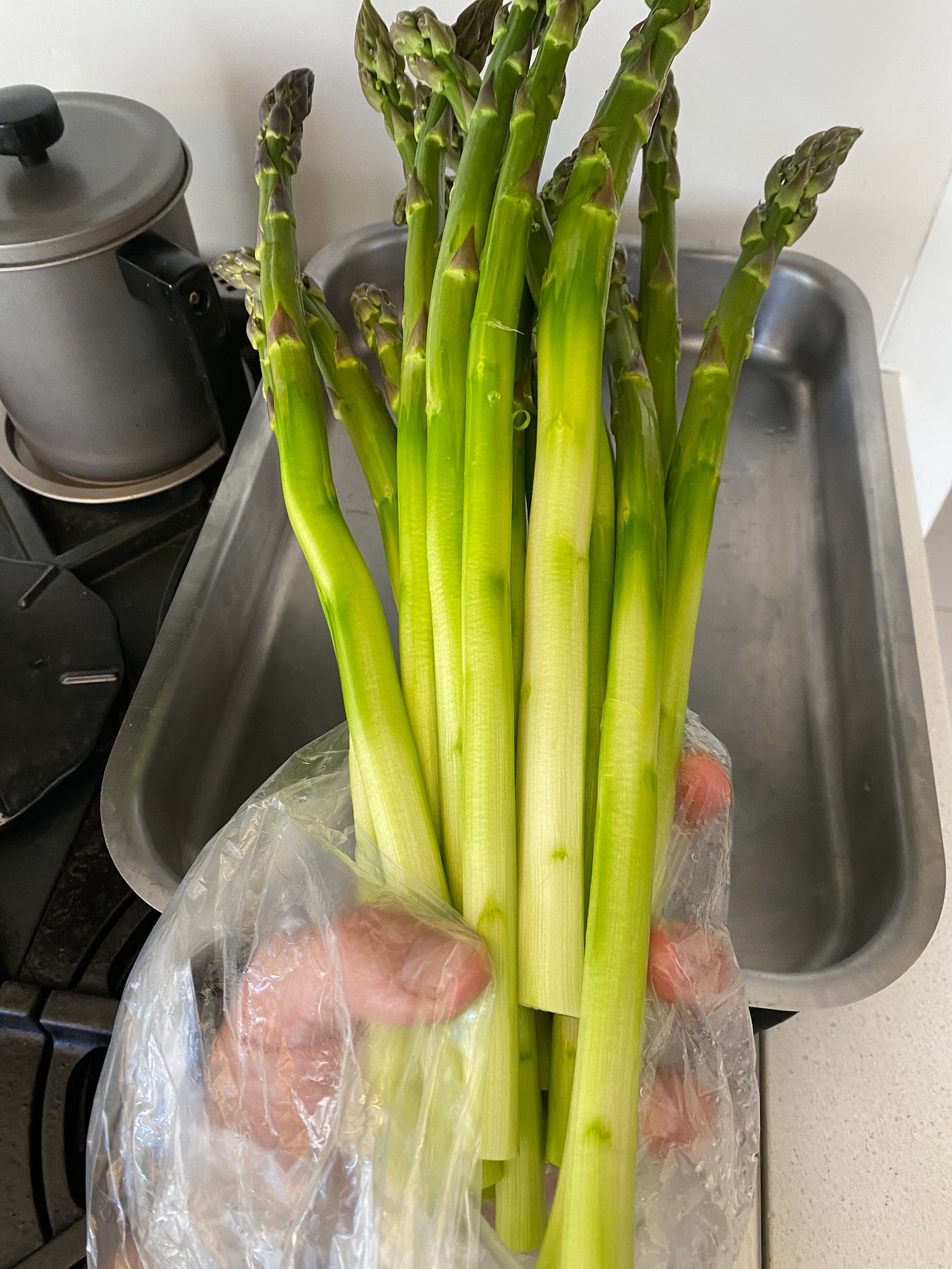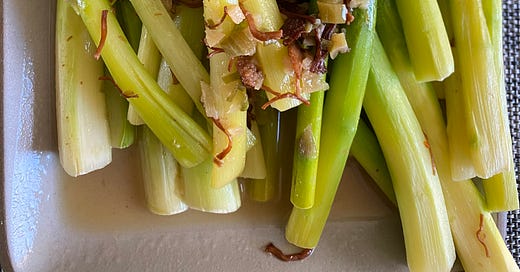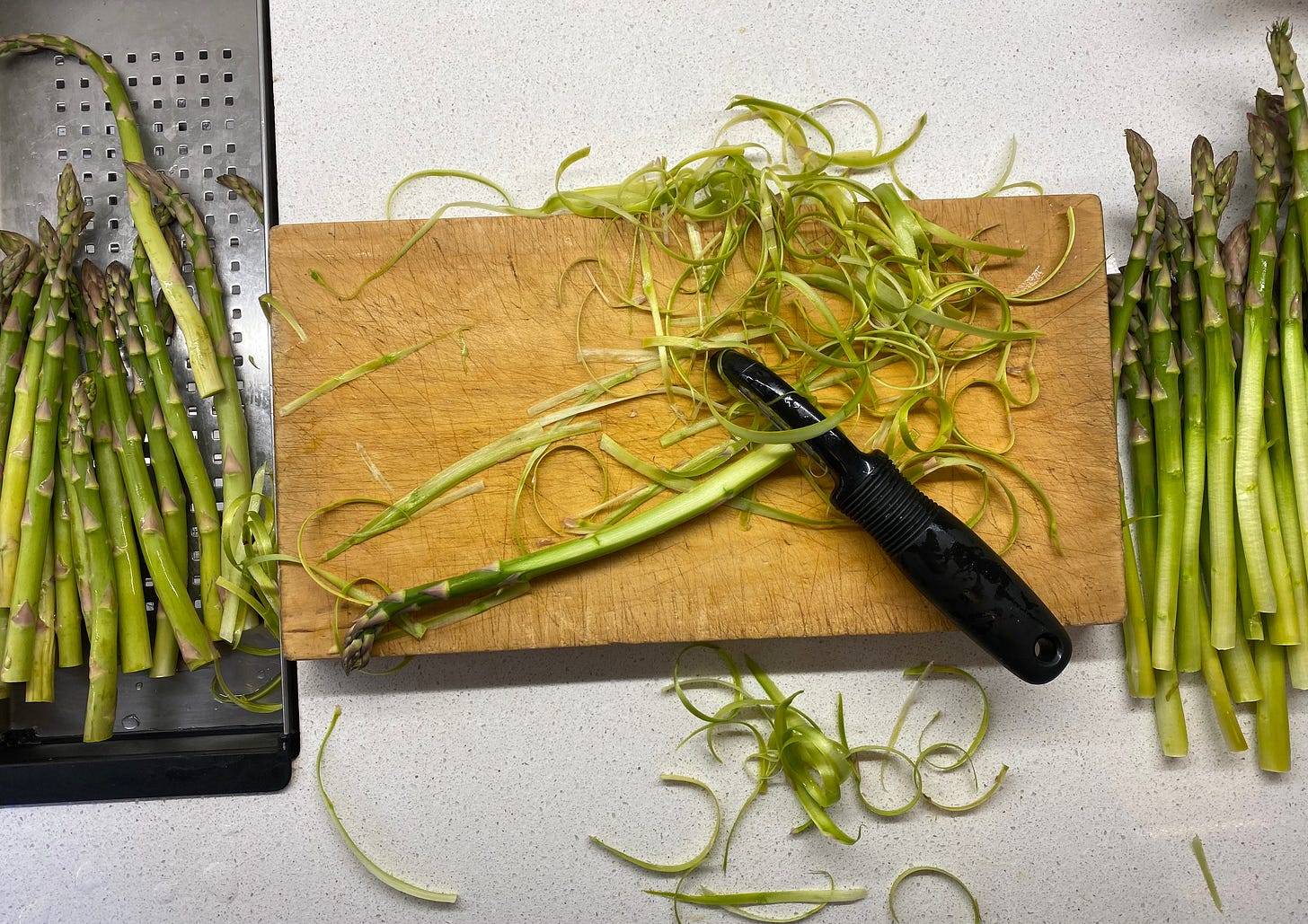Issue #2: Season's Eating: Asparagus
There's still time to enjoy the last of the season. To peel or not to peel? Steamed asparagus with miso butter. Storage tips. Plus thoughts about changing the work environment in restaurant kitchens.
Thank you to everyone who signed up and/or subscribed to my new newsletter after the first issue about the best apricot jam in the world (which you can make at home). I’m looking forward to being part of the community of cooks and other food-focused folks here on Substack and to sharing my recipes, tips, and advice with you all. Because my belief, my hope is that everyone is able to prepare simple, wholesome, delicious food, all who sign up will receive the newsletter for free. If you can afford to pay for a subscription, the support is much appreciated. Think of it like NPR—anyone can listen, those with means offer support. Paid subscribers will have access to the full archive and be able to comment and communicate with me directly, making special requests for recipes or advice, of which I’ve already received a couple. If you like what you read, please share with your friends and fellow cooks. Thanks, again. —Mitchell
Depending on where you live—especially where I am now in the unseasonably chilly northeast—there’s still a couple of weeks of local asparagus left. I got a few raised eyebrows when I posted this PSA on Instagram several weeks ago at the start of asparagus season: PEEL YOUR ASPARAGUS. A couple of folks didn’t know you could, let alone should, peel asparagus. Others said peeling asparagus was too much of a time suck and invited me over to peel theirs.
Of course, you should eat your asparagus however you like it. But I think that you will find that the tender, sweet glory of this spring delicacy is enhanced when you remove the fibrous outer layer of the stalks. I know people like to find the inflection point where the stalk snaps and use that as an indicator of what part to eat. But that seems both arbitrary and wasteful to me. Peeling allows you to eat more of the asparagus itself. #wastenot
I almost always look for the thickest, meatiest spears I can find. To my taste, thick asparagus have more flavor, especially if they are going to be boiled or steamed. The exception, for me, is when I’m in a real hurry and I intend to roast or grill them. Then I reach for the pencil-thin asparagus, and I don’t peel them so they maintain their integrity while facing the high heat.
RECIPE: Roasted or Grilled (Unpeeled) Asparagus
Preheat the oven to 425°F. or hotter if you can pay close attention. (Alternatively, preheat a grill to medium high.) Take a bunch or two or three of pencil-thin asparagus. Rinse and drain well. Toss with extra virgin olive oil, a generous amount of salt, and freshly ground black pepper, and bake or grill, turning often, until brown and crisp at the tips, maybe 10 to 15 minutes. Squirt with fresh lemon juice before serving hot or at room temperature. Sometimes I forget the asparagus in the oven and sort of burn them to charred twigs. Smoky and crisp, they are still delicious.
But the thicker the stalk, #imho the more imperative it is to peel.
TECHNIQUE: Peeling (Thick) Asparagus
To peel thicker asparagus, lay one stalk at a time flat on a cutting board and hold it gently but firmly below the tip. With a good, sharp vegetable peeler (I use an OXO peeler), begin to remove the peel from about 1/3 of the way down the spear toward the bottom in a long, gentle motion. Better to press too lightly than too hard. You can always repeat with more pressure, but if you press too hard you may break the stalk. You want to remove the darker green outer layer and leave as much of the whitish, light green core intact. Repeat over the same area, if necessary, to reveal the core. Turn the stalk after each stroke and continue peeling until you are done. No need for it to be perfect. Every strip you remove improves the eating. Cut off about ½ inch or so of the hardened bottom of the stock and repeat with the remaining spears.
I will admit that peeling asparagus takes some time, which seems to grow exponentially the more asparagus you have. Perhaps this expansion of time is because the peels can be messy, and they clog up the peeler and pile on the counter as you work. Periodically dispose of (compost) the peels as you go. Later in the day you will inevitably find curlicues of dried, stray asparagus peels on the floor, on canisters on the counter, in drawers. To prevent myself from becoming impatient, I just try to be present in the process of peeling, not focused on when the hell I’m going to be done. I think this mindset is required for a lot of the work of cooking. In fact, I think it is the secret both to enjoying cooking and to being a good cook. Let go and give yourself into the tasks at hand. (Easier said than done, I’m aware.) Letting go while cooking will be an ongoing theme of this newsletter.
LOCAL: Beautiful Asparagus
A couple of weeks ago I stumbled on the longest, most beautiful asparagus I have seen since I was a stagiaire at La Tour d’Argent in Paris back in the spring of 1990. I was rotating through all the stations in that venerable restaurant, which at the time still had its three Michelin stars. The only ingredient we interns were not allowed to touch was the giant asparagus, as it was too pricy and too delicate to let our inexperienced hands risk messing it up. Only the sous chefs peeled the asparagus. Like so many ingredients in that kitchen—live scallops and sea urchins in their shells, large lobes of fresh foie gras, ruddy ducks strangled to preserve their blood so that it could be pressed out of the roasted carcasses when the sauce was made in the dining room—I’d never seen anything quite like those asparagus. Each stalk was the size of a child’s arm. They were steamed and served on gondolas formed out of starched white linens folded to points that were curled and set on silver trays, a vat of hollandaise on the side.

The stunning green and purple asparagus at the Willow Wisp Organic Farm stand at the Union Square Greenmarket reminded me of those French spears. Almost 18 inches long and more than an inch thick, I just had to buy some, even at a hefty $15 a pound. My bunch came in at just under $60. I understood why all those many years ago I wasn’t allowed to touch the asparagus at La Tour d’Argent. I wouldn’t let anyone dare touch these. I very carefully transported my long green bouquet home and made space for it in the refrigerator standing at attention in a container of water in the door, the only place that would accommodate their height.
PARIS: Restaurant Kitchen, circa 1990
I must say, the ingredients weren’t the only thing new to me in the kitchens at La Tour d’Argent. Although I had worked in a couple of restaurant kitchens in Toronto before then, the intensity of the work and the harassment of the staff was a shock. You don’t have to look hard to find the roots of the current industry reckoning about how workers are poorly treated and undervalued in restaurant kitchens. The Tour d’Argent kitchen work was grueling, six days a week, 14-hours a day, with a scant two-hour break between lunch and dinner service, but only if you had finished the prep work at your station. (This was before France shortened the legal work week to 35 hours and fancy Parisian restaurants started closing on weekends as a result.)
The kitchen was divided among several floors in the ancient building on the bank of the Seine, so running up and down stairs constantly was part of the job. The chef stood at the pass on the upper floor and screamed commands and obscenities into the microphone of a speaker system that reached every corner of the back of house from the start of service until the end. Although I was in hotel school, I had taken my junior year abroad and the only thing I could get credit for were electives. So I was taking courses on philosophy and contemporary music at the Université de Paris. The chef found this amusing and so I was known as “le philosophe Américain.” “Faites monter le philosophy Américain,” he would bellow into the microphone when he wanted me to do to something. “Send the American philosopher upstairs.”
One of the most difficult stations was rôtisseur, where, in addition to being responsible for cooking those strangled ducks and other meat and game, the cooks were also in charge of the restaurant’s famous pommes soufflés. To make them, thin slices of potato are fried twice, first in a large copper vat of hot oil and then in a second, hotter vat of oil, that has to be swirled to create a kind of whirlpool that causes the slices to puff like pillows. The rôtisseur had to keep vats of oil swirling all night. His forearms were covered in welts from grease burns. One night, he brought something to the pass that wasn’t to the chef’s liking. The chef slapped him so hard across the face you could see his handprint in the rôtisseur’s cheek for the rest of service. “Oui, Chef!” He was demoted to cooking family meal. I recall discussing the working conditions with other cooks during one of those family meals. All they could say was the treatment here “wasn’t as bad as at Robuchon.” It was all so horrible and cliché.
At one time it was thought the finest cuisine could on be achieved in a militaristic, abusive kitchen. Young cooks, almost exclusively male, were indoctrinated into a hyper macho, hierarchical environment that they recreated in their own kitchens and so on. Certainly, the pressure in a top kitchen can be intense. But that is no excuse for an abusive, disrespectful environment. In the U.S., at least, that environment has been changing over the years. I remember when the first season of Top Chef was announced, a women friend of mine, a bread baker, who worked in the best restaurants and bakeries in New York City, said incredulously, “They are going to turn up the lights and bring cameras into a restaurant kitchen? The restaurant world better be prepared for what people are going to see.” I think we are still living through the reality of that revelation.
TODAY: Restaurant Work Must Change
Whether because of Top Chef or #MeToo or #BlackLivesMatter, and most likely because of all of them and more, the exposure of poor working conditions, harassment, and questionable HR practices revealed is forcing the restaurant industry to grapple with how to change the work environment and the business model of restaurants to make them more equitable and just. It’s no wonder why restaurateurs can’t find the help they need now for the “recovery” period. (Every chef and restaurateur I’ve spoken to in the last few weeks—in cities and rural areas, alike—cannot find enough staff to fully realize the potential for business they currently have.) It isn’t the unemployment benefits. First they treated the staff poorly, though in line with industry “standards”—no health insurance, no sick days, and likely exposure to COVID. Then they let everyone go, and many found it difficult to collect unemployment because of their sub minimum-wage, tip-reliant salaries. Now they want everyone to come back and pick up where they left off like nothing happened. It’s tough. There are many examples of places that did this all better than I just described, and presumably are having an easier time of it now. But so many more didn’t and aren’t.
None of the restaurants brought on the pandemic, of course, and the industry was struggling before and is now decimated. But the challenges revealed have made it really hard to imagine how it will come back to what it was before without some sort of systemic change. People I’ve spoken to who’ve left the industry say they have realized there is another life out there in the world of the be-your-own-boss, make-your-own-hours gig economy. It’s not that the gig economy gives you better benefits or any more security, necessarily, but they aren’t worse, either.
We have to collectively do something to repair the broken model of restaurants that devalues the people who participate in it and improve the quality of restaurant work so that the industry and its people can thrive. If we learned anything during the pandemic lockdown when restaurants were forced to close, it’s that restaurants not only contribute to our local economies, they contribute to our local communities. And I think we all stand something to gain if we can figure out how they can continue to do so in a way that is additive to those communities, rather than exploitative. More on that later. All of this is besides the asparagus point. But I also don’t want to keep leaving the people out of the food conversations. That’s part of the reason we are in this mess in the first place.
Now back to seasonal vegetables, I usually eat myself sick on asparagus during these weeks of spring. By the time I’m turning green around the edges and I don’t want to see it again until next year. And even though I paid an exorbitant amount for those lengthy asparagus at the Greenmarket, I’m not a spear snob. Much of the asparagus I (over)indulge on comes from NYC’s street carts, where $1 can get you a very decent bunch, which, if necessary, can be revived with a little loving care.
STORAGE TIP: Reviving and Maintaining Asparagus
Whether your asparagus has wilted and you want to revive it or you just want to keep it fresh longer, here’s what to do. Keep the band around the bunch. Cut off a 1/2- to 1-inch of the woody, dried ends of the talks. Stand the trimmed asparagus up in a glass or plastic container with an inch or so of cold water in it and set it in the fridge. It will plump and stay fresh for several days.
Once peeled, here’s a favorite and simple way of mine to prepare it.
RECIPE: Steamed (Peeled) Asparagus with Miso Butter
3 tablespoons unsalted butter, room temperature (our house butter is Kerry Gold)
3 tablespoons white miso (I like the subtle sweetness of saikyo miso from Kyoto but you can use any white miso)
1 or 2 bunches asparagus, peeled (see above)
Sea salt, fine and/or flaked
Garnish, such as chopped fresh herbs, preserved lemon, lemon juice, bacon bits, chopped egg, freshly ground black pepper, whatever you like or nothing at all (optional)
Using a small rubber spatula, combine the butter and miso in a small bowl, blending to make a smooth paste. Set aside. Find a covered frying pan that big enough to hold your asparagus in a single or at most double layer. (For the large Willow Wisp asparagus I had to use a roasting pan covered with aluminum foil.) Place about ½ an inch of water in the pan and a very generous pinch of salt. Bring to a boil. Add the asparagus, cover, turn down the heat, and let cook for 5 to 8 minutes depending on how thick they are and how cooked you like your asparagus to be. I have different moods—sometimes I like my asparagus softer, sometimes crunchier, depending. With tongs, remove the asparagus to a serving plate carefully so you don’t break it. (The stalks are more fragile when peeled.) While still hot, dab and spread the miso butter over the spears, jostling the plate to coat the spears as it melts. Sprinkle on some more salt, to your taste, any garnish you might be using, and serve warm. Be sure to spoon some of the buttery juices that collect on the plate onto each portion as you dish it out.
I love miso butter and use it finish many things, other vegetables, fish, soups. Make extra and keep it in your fridge to experiment.




